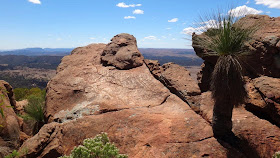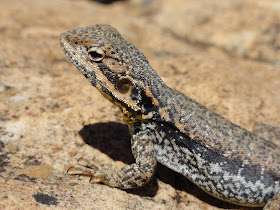"Life is too short to drink bad wine." Johann Wolfgang von Goethe. How true!
In 2012 we rode our bicycles from Adelaide to the Flinders Ranges and loved it. From the Barossa, the southern part of the Flinders is only a 200 km detour, so we decided to head north instead of west. Here's our camp for 3 nights in Wilpena.
On day two we climbed Mount Ohlssen Bagge (the name of the surveyor's business partner). What a great view of the surrounding areas!
On day three we rode our bicycles along the Mawson Trail to Bunyeroo Gorge and back. This was our favourite part of the trail, all downhill along the spectacular Heysen Range (except that now we had to ride back up to Wilpena!).
It's easy to understand why Sir Hans Heysen was so inspired by this landscape!
Before turning back we decided to do an 8 km walk into the Bunyeroo Gorge and back. It was another 36 degree day and riding the bikes up the hill was pretty tough!
Guess what this string across the road is?
An army of caterpillars marching single-file!
The creeks are lined with very old River Red Gums (Eucalyptus camaldulensis). Their bark is so beautiful with all the different colours and patterns!
On arrival we rode our bikes into Wilpena Pound and climbed a lookout. The inside of the pound is not as spectacular as the outside walls and the sign below explains why.On day two we climbed Mount Ohlssen Bagge (the name of the surveyor's business partner). What a great view of the surrounding areas!
The vegetation on top is amazing ......
.... and the Tawny Dragons (Ctenophorus decresii) are very cheeky.
By early afternoon the temperature reached 36 degrees and it was time for a cold beer!
On day three we rode our bicycles along the Mawson Trail to Bunyeroo Gorge and back. This was our favourite part of the trail, all downhill along the spectacular Heysen Range (except that now we had to ride back up to Wilpena!).
It's easy to understand why Sir Hans Heysen was so inspired by this landscape!
Before turning back we decided to do an 8 km walk into the Bunyeroo Gorge and back. It was another 36 degree day and riding the bikes up the hill was pretty tough!
On the way to the Gammon Ranges we camped in Mount Chambers Gorge. Just us and 2 million flies!
The gorge has aboriginal art, which we inspected during an early morning walk.
Guess what this string across the road is?
An army of caterpillars marching single-file!








































